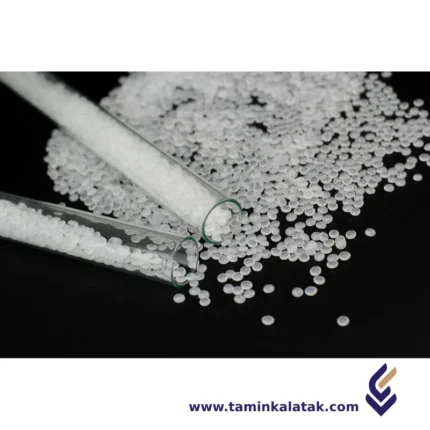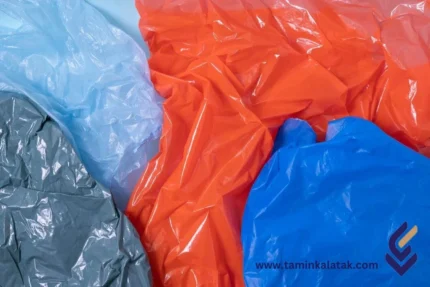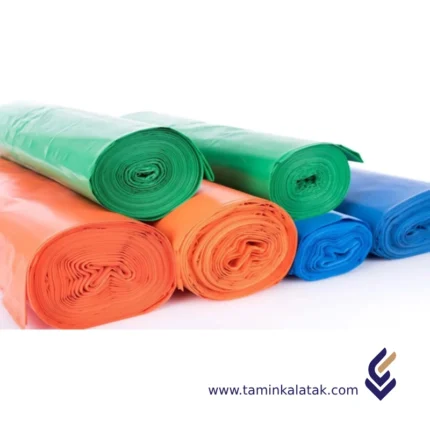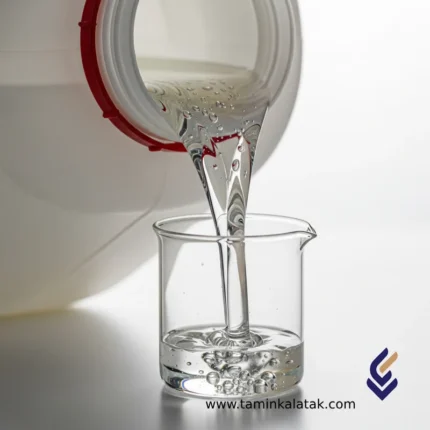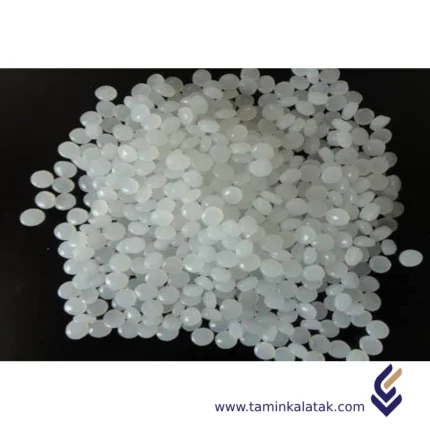Lauryl myristyl alcohol ethoxylated 2 mol
LDPE Compound
Structure LDPE Compound
The structure of an LDPE compound consists of a base polymer, which is low-density polyethylene (LDPE) with a highly branched molecular structure that gives it flexibility and low density. Fillers such as talc or calcium carbonate may be added to modify properties like rigidity, strength, and cost. Stabilizers, including antioxidants and UV stabilizers, help enhance thermal and environmental stability. Processing aids like lubricants and flow enhancers improve manufacturability, while plasticizers may be included to adjust flexibility. Pigments and additives can also be incorporated to achieve desired colors and functional properties. The overall composition of an LDPE compound depends on its intended application and performance requirements.Properties LDPE Compound
LDPE compound has a combination of properties that make it suitable for various applications. It is flexible, lightweight, and has a low density due to its highly branched molecular structure. It exhibits good impact resistance, excellent chemical resistance, and high moisture barrier properties, making it ideal for packaging applications. LDPE compound also has good electrical insulation properties, which make it useful in cable and wire coatings. It has a relatively low melting point, allowing for easy processing through extrusion, injection molding, and blow molding. The material is resistant to environmental stress cracking and has good transparency, although additives can be used to modify its appearance and mechanical properties. Its thermal stability and UV resistance can be enhanced with stabilizers, making it more durable for outdoor applications.Applications of LDPE Compound
- Packaging materials such as plastic bags, films, and wraps
- Containers, bottles, and squeeze tubes
- Wire and cable insulation
- Medical and pharmaceutical packaging
- Toys and household goods
- Agricultural films and greenhouse covers
- Coatings for paper cups and cartons
Advantages of LDPE Compound
- Highly flexible and lightweight
- Excellent chemical resistance
- Good impact strength and toughness
- Moisture-resistant with a good barrier to water
- Easy to process through extrusion, blow molding, and injection molding
- Good electrical insulation properties
- Transparent and printable for packaging applications
Disadvantages of LDPE Compound
- Lower tensile strength compared to other plastics
- Poor resistance to high temperatures and heat deformation
- Prone to environmental stress cracking
- Not as rigid or strong as HDPE
- Difficult to recycle in some cases due to contamination in mixed plastic waste
Lead Nitrate
Physical and chemical properties of lead nitrateSolubility: It is highly soluble in water and its aqueous solutions have a sweet taste. Strong oxidizer: Lead nitrate is a strong oxidizer and reacts violently with combustible materials. Thermal decomposition: When heated, it decomposes and produces nitrogen and lead oxides. Density: It has a high density.
applications of lead nitratePigment production: In the past, it was used as a raw material to produce yellow and orange pigments. Printing industry: It was used in the printing industry to fix color on fabric. Glass industry: It was used in the production of special glasses. Heat stabilizer: Used as a heat stabilizer in some polymers. Explosives: Used in the past in the manufacture of some explosives.
Dangers of lead nitrateHigh toxicity: All lead compounds are toxic, and lead nitrate is no exception. Ingestion, inhalation, or skin contact with lead nitrate can cause severe poisoning. Cumulative effect: Lead accumulates in the body and can cause damage to the kidneys, brain, nervous system, and reproductive system. Environmental hazards: Lead nitrate is very dangerous to the environment and can enter groundwater and soil, causing environmental pollution.
Light calcium carbonate
Light Calcium Carbonate (LCC) is an important inorganic mineral compound widely used across numerous industries due to its unique physical and chemical properties.
It is produced as a fine, white, lightweight powder and serves as an essential raw material in plastics, coatings, paper, rubber, and food industries.
Chemical Structure
Light Calcium Carbonate consists of calcium ions (Ca²⁺) and carbonate ions (CO₃²⁻).
In nature, it occurs in mineral forms such as calcite, aragonite, and marble.
Its crystalline structure provides excellent mechanical stability, chemical balance, and compatibility in a wide range of industrial formulations.
| Property | Description |
|---|---|
| Chemical Formula | CaCO₃ |
| Molecular Weight | 100.09 g/mol |
| Crystal Forms | Calcite, Aragonite |
| Bond Type | Ionic |
| Chemical Classification | Inorganic Carbonate |
Physical and Chemical Properties
| Property | Typical Value / Description |
|---|---|
| Appearance | Very fine, white, odorless powder |
| Bulk Density | Approx. 0.5–0.8 g/cm³ (light grade) |
| True Density | ~2.71 g/cm³ |
| Melting / Decomposition Point | ~825°C (decomposes to CaO + CO₂) |
| Solubility in Water | Practically insoluble |
| Solubility in Acids | Reacts with dilute acids, releasing CO₂ |
| Chemical Stability | Stable under normal conditions |
| pH (suspension in water) | Slightly alkaline |
| Toxicity | Non-toxic and environmentally safe |
Main Applications
1. Plastics and Polymers:
Used as a filler and reinforcing agent to improve rigidity, dimensional stability, and reduce production cost.
2. Paints and Coatings:
Acts as an opacifier and extender, enhancing whiteness, smoothness, and coverage.
3. Paper Industry:
Provides brightness, opacity, and smooth surface finish, improving print quality and reducing ink absorption.
4. Pharmaceuticals and Food Industry:
Used as a calcium supplement, pH regulator, and permitted additive in food and medicinal formulations (E170).
5. Rubber and Adhesives:
Improves tensile strength, elasticity, and workability in rubber compounds and sealants.
Advantages
-
Economical and widely available raw material.
-
Non-toxic and safe for both industrial and food-grade applications.
-
Improves mechanical properties and product durability.
-
Lightweight with uniform particle distribution.
-
Environmentally friendly and recyclable.
Limitations
-
Low water solubility limits its use in aqueous systems.
-
Dust generation during handling may cause mild respiratory irritation.
-
Reacts with acids, releasing CO₂ gas; should not be stored near acidic materials.
Safety and Handling
-
Store in a cool, dry, and well-ventilated area.
-
Avoid exposure to moisture to prevent lump formation.
-
Keep sealed containers away from acids and corrosive substances.
-
Use protective mask and gloves to minimize dust inhalation during handling.
Summary
Light Calcium Carbonate (CaCO₃) is a versatile, cost-effective, and safe mineral additive with broad applications in plastics, coatings, paper, rubber, and food.
Its fine particle size, high whiteness, and chemical stability make it one of the most commonly used fillers and performance enhancers in modern industrial formulations.
Light Stabilizers
- Building and Construction
- UV Absorbers & Hydroxybenzoates
- in UV absorbing substrates, such as polystyrenes,
- polyesters, etc.
- Medical
Light Truck Tires
Linear Low Density Polyethylene (LLDPE)
StructureLLDPE has a unique linear molecular structure with short, controlled branches. This structure is different from LDPE (Low-Density Polyethylene), which has long and irregular branches. LLDPE consists of ethylene monomers (–CH₂–CH₂–) linked in a linear fashion. It has short, uniform side branches created by copolymerizing ethylene with α-olefins (like butene, hexene, or octene).These branches prevent the polymer chains from packing too tightly, giving LLDPE low density and flexibility.
PropertiesLLDPE (Linear Low-Density Polyethylene) is a versatile thermoplastic polymer known for its excellent flexibility, high impact resistance, and good tensile strength. it is slightly denser than LDPE but less rigid than HDPE, making it ideal for applications requiring toughness and stretchability. It has a high elongation at break (>500%), allowing it to withstand significant stretching without tearing. LLDPE exhibits excellent chemical resistance against acids, bases, and alcohols while maintaining low water absorption, making it suitable for moisture-sensitive applications. Thermally, it has a melting point of approximately 110–125°C and remains functional between -50°C and 60°C. Though it lacks inherent UV resistance, stabilizers can be added to improve durability under sunlight. Its ease of processing through extrusion, blow molding, and film manufacturing makes it widely used in plastic films, flexible tubing, cable insulation, and various molded products. While lldpe is non-biodegradable, it is recyclable, contributing to sustainable material management.
Applications of Linear Low-Density Polyethylene (LLDPE)
- Packaging Industry:
- Stretch films and shrink wraps
- Plastic bags (grocery, trash, and industrial)
- Food packaging films (cling wraps, pouches)
- Agricultural Sector:
- Greenhouse films and mulch films
- Drip irrigation tubing and water storage tanks
- Industrial Applications:
- Pipes and fittings (flexible and durable)
- Cable insulation and protective coatings
- Industrial liners (chemical and water-resistant)
- Automotive Industry:
- Fuel tanks and hoses
- Interior soft components and protective covers
- Consumer & Household Products:
- Toys, containers, and household items
- Soft-touch grips and molded parts
- Medical & Pharmaceutical:
- Medical tubing and IV bags
- Sterile packaging films
Advantages of LLDPE
- Higher Flexibility and Toughness:
- More impact-resistant than LDPE
- Maintains durability even at low temperatures
- Excellent Chemical and Moisture Resistance:
- Resistant to acids, bases, and solvents
- Waterproof and corrosion-resistant
- Good Processability
- Lightweight and Cost-Effective
- Better Puncture and Tear Resistance:
- Ideal for thin film applications like stretch wraps
Disadvantages of LLDPE
- Lower Heat Resistance:
- Softens and deforms at high temperatures
- Not suitable for high-temperature applications
- Poor UV Stability:
- Requires UV stabilizers for outdoor use, or it degrades over time
- Lower Stiffness Compared to HDPE:
- Less rigid, making it unsuitable for structural applications
- Limited Gas Barrier Properties:
- Not ideal for gas-tight packaging applications
- Difficult to Process in Some Applications:
- Requires higher processing temperatures compared to LDPE
liquid Caustic
Caustic Soda Liquid, also known as Sodium Hydroxide Solution, is a highly alkaline, colorless, transparent, and strongly corrosive liquid typically produced and supplied in 30% to 50% concentrations by weight.
It is one of the most essential basic chemicals in global industry, widely used in processes such as neutralization, purification, etching, cleaning, and pH control.
Chemical Structure of Caustic Soda Liquid
-
Chemical Name: Sodium Hydroxide Solution
-
Chemical Formula: NaOH(aq)
-
CAS Number: 1310-73-2
-
Structure: Ionic solution containing Na⁺ and OH⁻ ions in water
-
Molecular Weight (NaOH): 40.00 g/mol
-
Common Industrial Concentration: 50% w/w (partially saturated solution at ambient temperature)
Physical and Chemical Properties (50% Solution)
| Property | Specification |
|---|---|
| Appearance: | Clear, colorless, odorless liquid |
| Density (20°C): | 1.515 – 1.520 g/cm³ |
| Freezing Point: | Approx. +12°C (hydrate crystallization begins at this concentration) |
| Boiling Point: | ~143°C |
| pH (1% solution): | Around 14 |
| Viscosity (20°C): | 3.4 – 3.6 mPa·s (higher than water) |
| Solubility in Water: | Complete – highly exothermic reaction |
| Appearance: | Transparent and free-flowing with no suspended particles |
Applications
1. Basic Chemical Industry
-
Neutralization of acids and pH regulation
-
Reactant in the production of detergents, bleaches, resins, paints, and adhesives
2. Water and Wastewater Treatment
-
pH adjustment and removal of heavy metal ions
-
Neutralization of acidic effluents
3. Pulp and Paper Industry
-
Used in the Kraft process for lignin separation from cellulose
-
Bleaching and paper recycling
4. Oil, Gas, and Petrochemical Industry
-
Gas sweetening (removal of H₂S and CO₂)
-
Purification of industrial oils and acid neutralization
5. Food Industry (Food Grade – FCC)
-
Cleaning-in-Place (CIP) systems for food processing lines
-
Olive curing (Lye Processing) and cocoa refining under controlled concentrations
Advantages
✅ Ready-to-use liquid form – suitable for direct dosing or injection
✅ High stability in solution – no need for prior dissolution
✅ Easier handling and transport compared to solid NaOH
✅ Versatile – applicable across chemical, food, and industrial sectors
Disadvantages
⚠️ Highly corrosive to skin, eyes, light metals, and non-resistant materials
⚠️ Exothermic reaction during dilution → always add caustic soda to water, never the reverse
⚠️ Requires corrosion-resistant storage tanks (HDPE or lined carbon steel)
⚠️ Absorbs CO₂ from air → gradual decrease in purity during long-term storage
Safety and Handling
GHS Classification:
-
H314: Causes severe skin burns and eye damage
-
P280: Use appropriate personal protective equipment
Required PPE:
-
Alkali-resistant gloves (Neoprene or PVC)
-
Safety goggles and face shield
-
Respiratory protection in areas with vapor or spray exposure
Emergency Measures:
-
Skin/Eye Contact: Immediately flush with plenty of cold water for at least 15 minutes and seek medical attention
-
Ingestion: Do not induce vomiting; drink plenty of water and seek emergency medical care
Storage Conditions
-
Store in HDPE tanks or epoxy-lined carbon steel containers
-
Optimal temperature: 15°C – 35°C
-
Keep away from acids, light metals, and chlorinated organic compounds
-
Avoid contact with moisture and CO₂
Standard Industrial Packaging
-
220-liter drums
-
1000-liter IBC tanks
-
Bulk transport in alkali-resistant tankers
Summary
Caustic Soda Liquid (NaOH 50%) is a versatile, high-strength alkaline solution essential for a wide range of industrial, petrochemical, and environmental applications.
Its ready-to-use form, strong reactivity, and broad compatibility make it one of the most widely used and economically valuable chemical bases in modern industry.
Liquid Rubber
Characteristics of liquid rubberHigh flexibility: After drying, liquid rubber turns into a very flexible layer that can withstand structural movements and prevent cracking. Strong adhesion: This material adheres well to various surfaces such as concrete, metal, wood, etc. and creates a seamless and integrated layer. Water and moisture resistance: Liquid rubber is completely impermeable to water and moisture and prevents water from penetrating into the structure. Resistance to chemicals: This material is resistant to many chemicals and is therefore also used in industrial environments. Long life: Liquid rubber has a long life and is resistant to atmospheric factors such as UV rays, heat and cold. Speed of application: Liquid rubber application is very fast and easy and does not require special equipment.
Liquid rubber applicationsBuilding insulation: Roof sealing, toilets, bathrooms, swimming pools, balconies and terraces Basement and foundation insulation Water tank coating Tunnel and bridge insulation Industry: Insulation of industrial tanks Metal surface coating Electrical equipment insulation Automotive: Car undercoating Fuel tank insulation
Low Density PolyEthylene (LDPE)
StructureLDPE (Low-Density Polyethylene) film grade is a thermoplastic polymer made from ethylene monomers (C₂H₄) through a high-pressure polymerization process. Its molecular structure is characterized by high branching, which gives it its unique properties. Key Structural Features: Highly Branched Polymer:
- LDPE has short-chain and long-chain branches, preventing tight packing of polymer chains.
- Due to branching, LDPE has low crystallinity (~40–50%), making it soft and transparent.
- It is more flexible and stretchable than HDPE (High-Density Polyethylene).
- LDPE has a broad molecular weight distribution, contributing to good melt strength and processability in film extrusion.
PropertiesLow-Density Polyethylene (LDPE) film grade is a highly flexible and lightweight material known for its excellent elongation, impact resistance, and transparency. With a density ranging from 0.915 to 0.930 g/cm³, it offers good clarity but can appear slightly hazy. It has a relatively low melting point of around 105–115°C and remains flexible even at sub-zero temperatures, making it suitable for various applications. LDPE exhibits moderate tensile strength (8–17 MPa) and exceptional elongation at break (100–600%), ensuring durability and resilience. While it provides a good moisture barrier, its gas barrier properties are poor, allowing oxygen and CO₂ to pass through. Chemically, LDPE resists acids, bases, and alcohols but is vulnerable to hydrocarbons. Its excellent heat-sealing properties make it ideal for packaging applications, including food wrap, shrink films, and shopping bags. Additionally, it is widely used in agricultural films, protective industrial films, and medical applications such as IV bags and tubing. LDPE is typically processed through blown or cast film extrusion, operating within a temperature range of 160–220°C. However, due to its susceptibility to UV degradation, stabilizers are often added for outdoor applications. Overall, LDPE film grade is a versatile and cost-effective material, valued for its flexibility, sealability, and ease of processing.
Applications
- Packaging
- Used for manufacturing flexible packaging films (e.g., shopping bags, wraps, and pouches).
- Food packaging, including wraps, freezer bags, and shrink films.
- Industrial packaging for wrapping materials, products, and protective covers.
- Agricultural Use
- Greenhouse films for agricultural purposes, creating protective environments for plants.
- Mulch films for soil coverage and weed control.
- Consumer Products
- Plastic bags for grocery stores, retail packaging, and garbage bags.
- Cling films for food preservation and covering items.
- Disposable liners for various containers.
- Construction
- Vapor barriers in buildings, preventing moisture from seeping into structures.
- Covers for construction materials during storage or transportation.
- Medical Use
- Sterile packaging for medical devices, equipment, and pharmaceuticals.
- Medical drapes and covers.
Advantages
- Flexibility
- LDPE film is highly flexible and can be stretched without breaking.
- Transparency
- Offers high clarity and transparency, making it ideal for packaging.
- Chemical Resistance
- Good resistance to chemicals, oils, and greases.
- Low Cost
- Relatively affordable material, making it a cost-effective solution for many applications.
- Ease of Processing
- Easy to process with methods like extrusion, injection molding, and blow molding.
- Lightweight
- Lightweight material, reducing transportation and handling costs.
- Moisture Resistance
- Water-resistant properties, providing good moisture protection in packaging.
Disadvantages
- Low Strength
- Low tensile strength and can tear easily under stress or load.
- Limited Heat Resistance
- Has a low melting point, which limits its use in high-temperature environments.
- Environmental Impact
- Non-biodegradable and contributes to plastic pollution if not recycled properly.
- Poor UV Resistance
- Can degrade when exposed to UV light, leading to brittleness and color fading over time.
- Low Barrier Properties
- Not ideal for barrier applications like gas or vapor resistance compared to other materials like BOPP or PET.
Low Density PolyEthylene Injection (LDPE)
StructureThe structure of LDPE injection molding grade is characterized by a highly branched, amorphous polymer configuration, which distinguishes it from other forms of polyethylene such as High-Density Polyethylene (HDPE). The polymer chains in LDPE are irregularly branched, meaning the chains do not pack closely together, resulting in a low degree of crystallinity. The polymerization of LDPE occurs through free-radical polymerization, typically under high pressure, which causes the long chains of the polymer to have side branches. For the injection molding grade, the polymer structure is tailored to achieve a higher melt flow index (MFI), which facilitates the material's smooth flow and filling into injection molds.
PropertiesLDPE injection molding grade is a versatile polymer characterized by its high degree of branching and amorphous structure, which results in excellent flexibility. This material ensures smooth and efficient flow during the injection molding process. This makes it suitable for producing intricate parts with good surface finish. LDPE injection molding grade exhibits moderate tensile strength (around 8-12 MPa) and excellent elongation at break, providing resistance to cracking and impact. The material is also known for its good chemical resistance, particularly against acids, bases, and alcohols, while being less resistant to hydrocarbons. Additionally, it offers low moisture absorption and performs well under low temperatures, maintaining its flexibility. LDPE is easy to process and heat sealable. Despite its high impact resistance and toughness, it has a relatively low stiffness compared to higher-density polyethylene grades.
Applications
- Consumer Products:
- Household containers, lids, and dispensers
- Toys and other recreational items
- Furniture parts and lightweight molded components
- Packaging Industry:
- Caps, closures, and flexible lids
- Cosmetic and personal care packaging
- Food storage containers (FDA-approved grades)
- Medical & Pharmaceutical:
- Syringes, laboratory equipment, and sterile packaging
- Medical device housings and disposable instruments
- Industrial & Electrical:
- Cable coatings and wire insulation
- Protective covers and soft-touch components
- Pipes and low-pressure fittings
- Automotive Industry:
- Interior trims, protective covers, and soft components
- Fluid storage containers and under-the-hood parts
- Construction & Agriculture:
- Waterproofing membranes, gaskets, and sealants
- Molded irrigation components
Advantages
- Excellent Processability
- High Flexibility & Impact Resistance
- Lightweight Material
- Good Chemical & Moisture Resistance
- Food-Safe and Non-Toxic
- Cost-Effective
Disadvantages
- Low Mechanical Strength
- Limited Heat Resistance
- Poor UV Resistance
- Not Biodegradable
- Weak Barrier Properties


